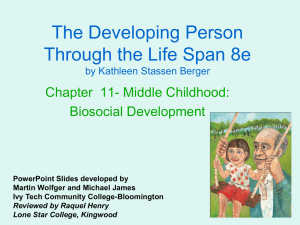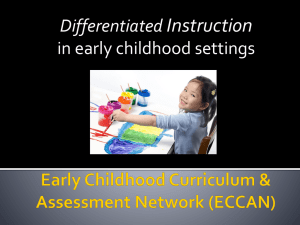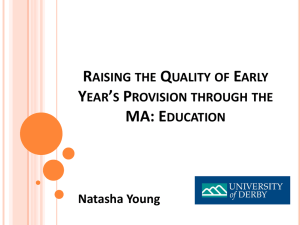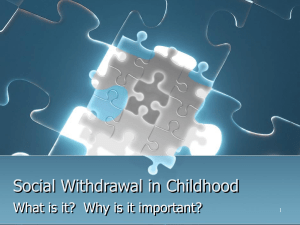Evaluation of Early Childhood Mental Health Systems of Care
advertisement
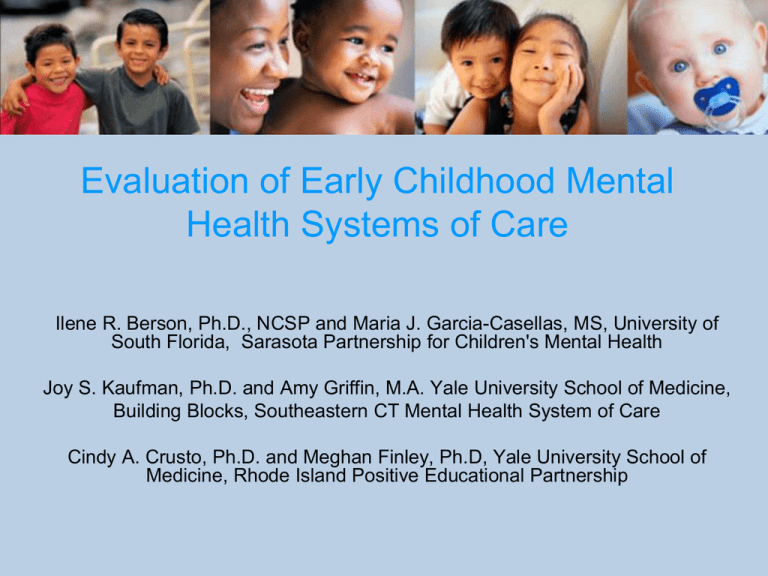
Evaluation of Early Childhood Mental Health Systems of Care Ilene R. Berson, Ph.D., NCSP and Maria J. Garcia-Casellas, MS, University of South Florida, Sarasota Partnership for Children's Mental Health Joy S. Kaufman, Ph.D. and Amy Griffin, M.A. Yale University School of Medicine, Building Blocks, Southeastern CT Mental Health System of Care Cindy A. Crusto, Ph.D. and Meghan Finley, Ph.D, Yale University School of Medicine, Rhode Island Positive Educational Partnership BRIEF WEBINAR ORIENTATION Upon entering the webinar, your screen should look like this. You may be prompted to enter your telephone number in the pop-up window. Doing so will allow you to participate in the audio portion of the webinar. Remember to enter the number of the phone that you will be using for the webinar. Use the Chat (Q&A) pod to ask a question or respond to a general question to the audience. For further technical assistance regarding the webinar platform or to troubleshoot specific issues, please call 202-687-5000 for assistance. Setting the Context Early Childhood System of Care Communities • Graduated Communities – Denver, CO – State of Vermont • 2005 Cohort – Allegheny County, PA – Los Angeles County, CA – Multnomah County, OR – State of Rhode Island* – Sarasota, FL* – Southeastern Connecticut* Early Childhood SOC Communities (cont’d) • 2008 Cohort – Burlington, NC – State of Delaware – Fort Worth, TX – State of Kentucky • 2009 Cohort – Alameda County, CA – Boston, MA – Guam Evaluation of Early Childhood Mental Health Systems of Care Ilene R. Berson, Ph.D., NCSP and Maria J. Garcia-Casellas, MS, University of South Florida, Sarasota Partnership for Children's Mental Health Joy S. Kaufman, Ph.D. and Amy Griffin, M.A. Yale University School of Medicine, Building Blocks, Southeastern CT Mental Health System of Care Cindy A. Crusto, Ph.D. and Meghan Finley, Ph.D, Yale University School of Medicine, Rhode Island Positive Educational Partnership Acknowledgements Building Blocks, Southeastern Mental Health System of Care • Kathleen Bradley, Ph.D., PI • Sue Radway, Ed.D., PD • Gigi Rhodes, LCSW, CS • Deirdre Cotter Garfield, MSW Families United •Miralys Camelo, Eval Assistant Rhode Island Positive Educational Partnership • Janet Anderson, Ed.D., PI • Anthony Antosh, Ed.D. Co-PI • Ginny Stack, MA, PD • Frank Pace, MSW, CD • Cathy Ciano, PSN RI •Jo-Ann Gargiulo, Eval Assistant Sarasota Partnership for Children's Mental Health •Chip Taylor, MPA, PI •Sarah Cloud, RN, MS, PD •Kristie Skoglund, Ed.D., LMHC, CD •Kelly Lewin, FSN Early Childhood Systems of Care (EC-SOC) • EC-SOCs develop services and supports for children aged birth to eight years, and their families to: – promote positive mental health – prevent mental health problems, and – provide mental health interventions • Although the rates of severe emotional disturbance in young children is nearly identical to that in older children (Egger, 2009), SOCs have almost exclusively served adolescents and school-aged children (Kaufmann & Hepburn, 2007). • Although a growing number of EC-SOCs are being supported, little is known across communities regarding: – demographic and background characteristics of these children – experiences that may have and continue to place them at risk for or protect them from psychiatric difficulties Building EC Knowledge Base • In response to this gap in knowledge, the Phase V Early Childhood sites came together to: – work with the national evaluation team to modify/add appropriate data elements for the early childhood population – select several common outcome measures so that more relevant longitudinal data could be gathered about young children – agree to share data so that it could be aggregated across sites Purpose of Presentation • To present data pooled from three SAMHSA CMHS funded EC-SOC communities to: – Better understand who are the young children aged birth to eight years and their families served. – Report on factors that may have increased children’s risk for social, emotional, and/or behavioral challenges or protected them from these difficulties. – Examine the mental health trajectories of young children served in these SOC communities. – Discuss work of the Diagnosis and Eligibility Workgroup including review of imminent risk. – Describe efforts to validate some DC 0-3R diagnoses. Collaborating EC SOCs • Our three communities were funded in 2005 (Phase V) • Range in ages served (birth through 11 years) • Population of focus differs • Intervention of focus differs • Continuum of mental health services and supports are similar New London Building Blocks • An initiative of the Southeastern Mental Health System of Care (SEMHSOC) in partnership with Families United, CT Department of Children and Families, Child and Family Services, United Community and Family Services, LEARN • Children under six years with serious social, emotional, and mental health challenges and their families • Serving all of New London County with a focus on underserved populations including military families, Hispanic/Latino families, teen parents, and homeless families • 300 children and their families to receive care coordination and a home-based intervention that focuses on the parent-child relationship and utilizes techniques of PBS Rhode Island Positive Educational Partnership (RIPEP) • Partnership among DCYF, RIDE, Sherlock Center, and early childhood systems • Integration of RI PBIS statewide initiative, RICASSP SOC and continuum of children’s behavioral health services, and early childhood systems • Children aged birth through11 years with serious social, emotional, and mental health challenges and their families • 80 schools/ECE sites will be involved • 700 children and families to be served Sarasota Partnership for Children’s Mental Health • Comprised of representatives of the health department, mental health service agencies, school district, early learning and care community, and numerous other child serving organizations. • The population of focus includes children birth through age 8 and family members at risk of disrupted relationships due to a) foster care placement or risk of placement, b) prenatal exposure to alcohol and other substances, c) risk of expulsion or exclusion from early learning environments, and/or d) the presence of other environmental stressors (i.e., domestic violence, poverty, caregiver mental illness, homelessness). The children have a DC:0–3R or DSM-IV-TR diagnosis and prognosis that mental health challenges will last at least one year and require multi-agency interventions from at least two community service agencies. • Approximately 400 children and families expected to receive care coordination Procedure • Descriptive Data (demographic and diagnostic) must be collected at intake and submitted for: – All youth and families supported and served by the CMHSfunded system of care • Data sources: – Administrative records – Caregivers – Evaluators (for specific questions) • Family Descriptive Information collected during Child and Family Outcome Study (every 6 months): – Intake data reported on here • Data source: – Caregiver participating in Outcome study Outcome Study Measures Domain Parenting/ Family Context National Evaluation Additional EC Measures Caregiver Strain Questionnaire (CGSQ) Parenting Stress Index (PSI) Caregiver Information Questionnaire (CIQ) Center for Epidemiology Depression Scale (CES-D) Family Life Questionnaire (FLQ) Addictions Severity Index (ASI) Living Situations Questionnaire (LSQ) Trauma Exposure Social/ Emotional Challenging Behaviors Traumatic Events Screening Inventory (TESI) Child Behavior Checklist (CBC) Brief Infant-Toddler Social Emotional Assessment (BITSEA) Vineland Screener (VS) Devereux Early Childhood Assessment – Social Emotional (DECA-SE) Columbia Impairment Scale (CIS) Emotional Regulation School Experience Temperament and Atypical Behaviors Scale (TABS) Educational Questionnaire (EQ) Early Care and Education Stability Scale (ECES) Findings System of Care Community System of Care Community (n = 728) New London Building Blocks (NLBB) 21.8% Rhode Island Positive Educational Partnership (RIPEP) 21.2% Sarasota Partnership for Children's Mental Health 57.0% Demographics (n=728) Gender Male 73.5% Female 26.5% Average Age at Intake 4.64 years Age Distribution < 1 year 2.7% 1 year 3.8% 2 years 9.1% 3 years 15.2% 4 years 17.3% 5 years 17.7% 6 years 11.3% 7 years 11.3% 8 years 11.5% Demographics, cont. Race/Ethnicity (n = 701) American Indian or Alaska Native 1.1% Black or African American 22.1% White 60.0% Other 12.3% Hispanic/Latino Background (n = 701) Yes 16.8% Custody Status N=370 Referral Source (n=708) Presenting Problems (n=427) Presenting Problems Reported for Young Children (n=465) 4.10% Feeding Problems Disruptive Behaviors 16.30% Persistant Non-Compliance 27.30% Excessive Crying/Tantrums 11.00% Separation Problems 2.60% Non-Engagement with People 15.90% Sleeping Problems 11.00% Excluded from Preschl/Childcare Due to … At Risk for/has Failed Family Home… 2.40% 5.80% Maltreatment 4.50% Other Problems of Child Health 7.30% Parent/Caregiver Mental Health 7.70% Parental/Caregiver Substance Use/Abuse 3.00% Family Health Problems Other Family Problems 0.80% 9.50% Housing Problems 5.20% Other Early Child Problems 0.00% 10.00% 20.00% 30.00% 40.00% 57.80% 50.00% 60.00% 70.00% Educational Information Attended an early childhood program in the last 6 months (6 and younger; n=275) Have an IEP (n=207) 82.5% 42.0% IEP is for Behavioral Health Issues (n=87) 75.6% School Disciplinary Issues in the 6-months Prior to Enrollment (n=210) Suspended 14.8% Expelled 2.9% Suspended and Expelled 1.9% Health History Children who have: Have a primary care physician (n=373) 95.4% Recurring health problem (n=373) 38.9% On medication for recurring health problem (n=370) 23.3% Hospitalized in past 6-months for recurring health 2.8% problem (n=351) Family Characteristics Children live in homes with: Other children M=1.43 Adults M=1.86 Family Income: Below Poverty 58.1% At or Near Poverty 15.6% Above Poverty 26.3% Caregiver Employment: Worked in last 6-months 58.5% Hours worked per week M=31.9 Child and Family Risk Factors Caregivers Reported: Family history of depression (n=356) 68.8% Family history of mental illness (n=358) 46.6% Family history of substance abuse (n=363) 52.3% Has the child ever: Witnessed domestic violence (n=363) 38.0% Lived with someone who is depressed (n=361) 62.6% Lived with some with a mental illness (n=358) 45.2% Lived with someone convicted of a crime (n=362) 36.7% Lived with someone w/a substance abuse problem (n=362) 39.2% Been physically abused (n=359) 9.7% Been sexually abused (n=355) 3.9% Run away (n=367) 9.5% Talked about suicide (n=373) 9.7% Attempted suicide (n=365) 1.9% Services Received Prior to Enrollment Any Service 32.4% Outpatient Services School-based Services Day Treatment Residential Treatment 31.0% 23.4% 2.9% 2.2% Substance Abuse Treatment -- Preliminary Results from Longitudinal Outcome Study Procedure • Supplemental measures to the SAMHSA required Longitudinal Child and Family Outcome Study – – – – Baseline, 6months, 12 months Caregiver report Interviews conducted by trained interviewers Interviews conducted in caregivers’ preferred or primary language – Interviews conducted in family’s home or another location Outcome Study Measures Domain Parenting/ Family Context National Evaluation Additional EC Measures Caregiver Strain Questionnaire (CGSQ) Parenting Stress Index (PSI) Caregiver Information Questionnaire (CIQ) Center for Epidemiology Depression Scale (CES-D) Family Life Questionnaire (FLQ) Addictions Severity Index (ASI) Living Situations Questionnaire (LSQ) Trauma Exposure Social/ Emotional Challenging Behaviors Traumatic Events Screening Inventory (TESI) Child Behavior Checklist (CBC) Brief Infant-Toddler Social Emotional Assessment (BITSEA) Vineland Screener (VS) Devereux Early Childhood Assessment – Social Emotional (DECA-SE) Columbia Impairment Scale (CIS) Emotional Regulation School Experience Temperament and Atypical Behaviors Scale (TABS) Educational Questionnaire (EQ) Early Care and Education Stability Scale (ECES) Risk Factors and CBC Analysis • Predictors (Risk factors): – number of different types of trauma events – maternal depressive symptoms – parenting stress (total scale) • Controlled for: child’s age and child’s gender • Outcome: CBC total problems score at baseline, 6-, and 12-months Risk Factors and CBC Results • CBC Total Problem Scores decreased over time • At baseline – number of different types of trauma events experienced was significantly related to higher CBC scores – lower levels of maternal depression were significantly related to higher CBC scores – higher parenting stress was significantly related to higher CBC scores • Parenting stress was significantly related to trajectory of CBC scores over time – children whose parents had higher parenting stress at baseline improved more quickly than children whose parents reported less stress at baseline Protective Factors and CBC Analysis • Predictors (Protective factors): – DECA: Initiative, self-control, attachment • Controlled for: child’s age and child’s gender • Outcome: CBC total problems score at baseline, 6-, and 12-months Protective Factors and CBC Results • At baseline – higher self control was significantly related to lower CBC scores – older children were significantly more likely to have higher CBC scores • Only age was significantly related to trajectory of CBC scores over time – older children started out higher on CBC at baseline but exhibited fewer problems at 6 months Discussion • With regard to risk factors, parenting stress was significantly related to trajectory of CBC scores over time – potential benefits to early intervention – clinical vs. statistical significance • In the examination of protective factors, only age was significantly related to trajectory of CBC scores over time – older children started out higher at baseline but exhibited fewer problems at 6 months Translating Research into Practice: Imminent Risk and a Public Health Approach to Early Childhood A Public Health Approach to Early Childhood • Promotion of positive mental health through comprehensive service delivery • Prevention of conditions commonly associated with emotional disorders, including exposure to trauma, to preserve young children’s mental health. • Earliest possible identification and intervention in mental health problems, to restore positive functioning and well being. • The approach focuses on both strengthening services and supports for children with serious emotional disorders and their families, and on prevention and early intervention strategies for all children. • To achieve this public health approach, cross-system partnerships are needed within communities to implement and sustain such services. Public Health Implications • Enhance Early Childhood System of Care Eligibility – Imminent risk • Resilience-informed approach – Focus: promote resilience – Goal: reduce negative outcomes • Future directions – Explore additional risk factors – Identify/design screening tools Early Childhood Community of Practice Diagnosis and Eligibility Workgroup • Convened at Early Childhood Pre-Conference meeting in New Orleans, July 2007 • Draft Concept Paper presented to the Early Childhood Community of Practice participants at the Training Institutes in July, 2008 in Nashville Imminent Risk • Cumulative risk screening that may help focus preventive intervention where it will be most efficient and effective (e.g. based on number of risk factors experienced, occurring after risk exposure and before development of problems, in the context of service resources, etc.). • Appropriate screening tools can be used to identify children and get them into the services they need to prevent young children from developing more severe and persistent disorders. Resilience-Informed Approach • Combination of high risk-status and inadequate protective factors compound to intensify the detrimental effect on a child’s functioning and emotional well being. The results of our research highlight the relevance of risk and resilience to early childhood mental health. • Since children are impacted greatly by adult risk behaviors (i.e., mental illness, drug abuse, criminal activity), a complementary focus on strengthening protective factors and promoting resilience within the family may help reduce the negative outcomes of current and future risk exposure. Summary and Next Steps • Study results support using trauma exposure and protective factors to identify children at imminent risk for emotional and behavioral problems. • Early intervention efforts should focus on strengthening protective factors and promoting resilience, which may reduce the negative outcomes of current and future risk exposure. • Future directions should include the development and application of screening tools to identify risk and resilience for early childhood mental health. • Ongoing research should investigate additional risk factors (e.g., prenatal tobacco, alcohol, and/or drug use, caregiver strain, poverty) that may place children at imminent risk for emotional and behavioral problems. Validation of the DC 0-3R Developing Diagnostic Classification Systems for Young Children • “Research data in preschool psychopathology are so scant that the extrapolation of most diagnoses to preschool age is unsupported by any convincing research data.” (Postert et al., 2009) • Challenges – Preschool children are limited in their ability to self-report due to cognitive immaturity and limited verbalizing skills – Compared to other age groups, preschool children represent the group most variable in developmental changes in important domains like emotional regulation, interpersonal interactions, play, control of physical functions, motor skills and language. – Thresholds for the frequency of symptomatic behavior in older children are not transferable to preschoolers if these behaviors are developmentally normal in young children. – In early child mental health development biological and environmental factors closely interact requiring a dynamic model of mental health development. However, the difficulty of developing reliable measurements of relationship factors remains a serious empirical challenge. Challenges of Diagnostic Classification Systems • DSM IV – Offers only a small number of child psychiatric disorder categories for young children and lack developmentally sensitive adaptations – Lacks integrated emphasis on contextual factors influencing developmental psychopathology in young children, i.e., child-parent attachment, parental sensitivity and interactive behavioral patterns • Research Diagnostic Criteria––Preschool Age (RDC-PA) – 2001 to 2002 task force from the American Academy of Child and Adolescent Psychiatry (AACAP) – Aim: devise complementary and developmentally sensitive modification to the appropriate categories of DSM-IV-TR based on empirical data – 17 diagnostic categories of the DSM-IV classification system were deemed relevant to children ages 0-5 years • Agoraphobia without history of panic disorder, social phobia, obsessive compulsive disorder and generalized anxiety disorder have insufficient evidence-based data to warrant a revision but their clinical relevance to young children required their provisional inclusion into RDC-PA without proposal for modification. Purpose of the Diagnostic Classification: 0-3R (DC:0-3R) • To focus on the first 3-4 years • To provide a developmentally sensitive diagnostic tool for young children that frames diagnosis as an ongoing process and leads to the development of a comprehensive prevention and/or treatment plan • To consider the impact of relationships and obtain a complete understanding of a young child, in the context of his/her family • To consider problems/behaviors not captured by other classification systems • To complement other systems (e.g., DSM, ICD) DSM–IV Axis I & II Diagnoses Children 4-8 Years of Age Diagnosis (n = 277) % Attention Deficit/Hyperactivity 30.3% Adjustment Disorders 27.8% Disruptive Behavior Disorders 19.5% Anxiety Disorders 10.1% PTSD 8.7% Oppositional Defiant Disorder 7.6% Mood Disorders 6.9% Pervasive Developmental Disorders 6.1% Other 9.1% Because children/youth may have more than one diagnosis, percentages for diagnoses may sum to more than 100%. [a] Substance Use Disorders include caffeine intoxication. [b] V Code refers to Relational Problems, Problems Related to Abuse or Neglect, and additional conditions. Percentage excludes V71.09 (No Axis I or II diagnosis). DC:0-3R Axis I Diagnoses Children 0-3 Years of Age Clinical Diagnosis (n = 97) % Adjustment Disorders 32.9% Anxiety Disorders 14.4% Sensory Stimulation-Seeking/Impulsive 13.4% Hypersensitive 12.4% Regulation Disorders 7.4% Mixed Disorders of Emotional Expressiveness 4.1% Sleep Disorders 4.1% PTSD 2.1% Other 6.1% Because children/youth may have more than one diagnosis, percentages for diagnoses may sum to more than 100%. DC: 0-3 R Diagnosis ICD-9-CM Diagnosis 220 Anxiety Disorders of Infancy and Early Childhood 221 Separation Anxiety Disorder Specific Phobia 309.21 Separation anxiety disorder 300.29 223 Social Anxiety Disorder (Social Phobia) 300.23 Other isolated or specific phobias Acrophobia, animal phobias, claustrophobia, or fear of crowds Social phobia Fear of eating in public, speaking in public, washing in public 224 Generalized Anxiety Disorder Anxiety Disorder NOS 300.02 Generalized anxiety disorder 300.00 Anxiety state, unspecified 222 225 430 DC: 0-3 R Diagnosis Sensory StimulationSeeking/Impulsive 314.01 ICD-9-CM Diagnosis Attention deficit disorder with hyperactivity Combined type Overactivity NOS Predominantly hyperactive/impulsive type Simple disturbance of attention with overactivity 314.1 Hyperkinesis with developmental delay Developmental disorder of hyperkinesis 314.9 Unspecified hyperkinetic syndrome Hyperkinetic reaction of childhood or adolescence NOS Hyperkinetic syndrome NOS 313.9 Unspecified emotional disturbance of childhood or adolescence Anxiety Sensory StimulationSeeking/Impulsive 50% 50% 4.7 years 86% 14% 4.3 years 3.7-5.8 years 2.8 years Boys Race Black or African American White Multi-Racial 4.5-4.7 years 2.8-5.3 years 75% 86% 14% Hispanic/Latino Background 50% 29% Demographics Gender Male Female Average Age at Intake Age Group Girls 25% Average Scores of Child Behavioral and Emotional Problems for Children Ages 1½ to 5 at Intake Borderline Clinical Clinical CBCL 1½-5 Average Syndrome Scale Score 25% 25% 64 (Range 59-79) 0% 0% 58 (Range 50-60) Sensory Stimulation-Seeking/Impulsive Anxious/Depressed T-Score 14% 14% 62 (Range 50-74) Attention Problems T-Score 29% 68 (Range 57-73) Measure Anxiety Anxious/Depressed T-Score Attention Problems T-Score 57% For the syndrome scales, T scores less than 67 are considered in the normal range, T scores ranging from 67-70 are considered to be borderline clinical, and T scores above 70 are in the clinical range. Looking Toward the Future Next Steps • Our sites will continue to collect this data. • Plan to submit a R01 this June to create a data repository so that we can pool the data across sites to allow for a more comprehensive understanding of the characteristics of children served and the impact of EC SOCs for young children and their families overtime.


